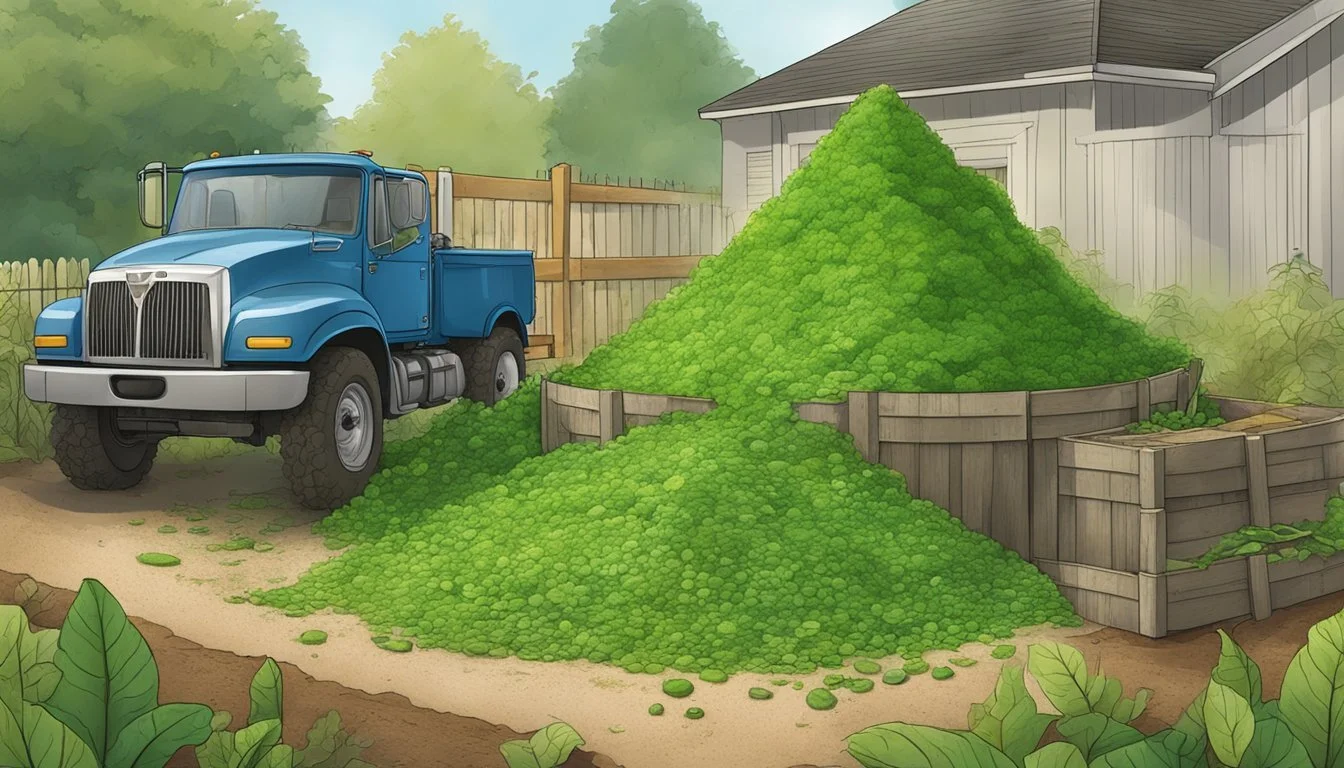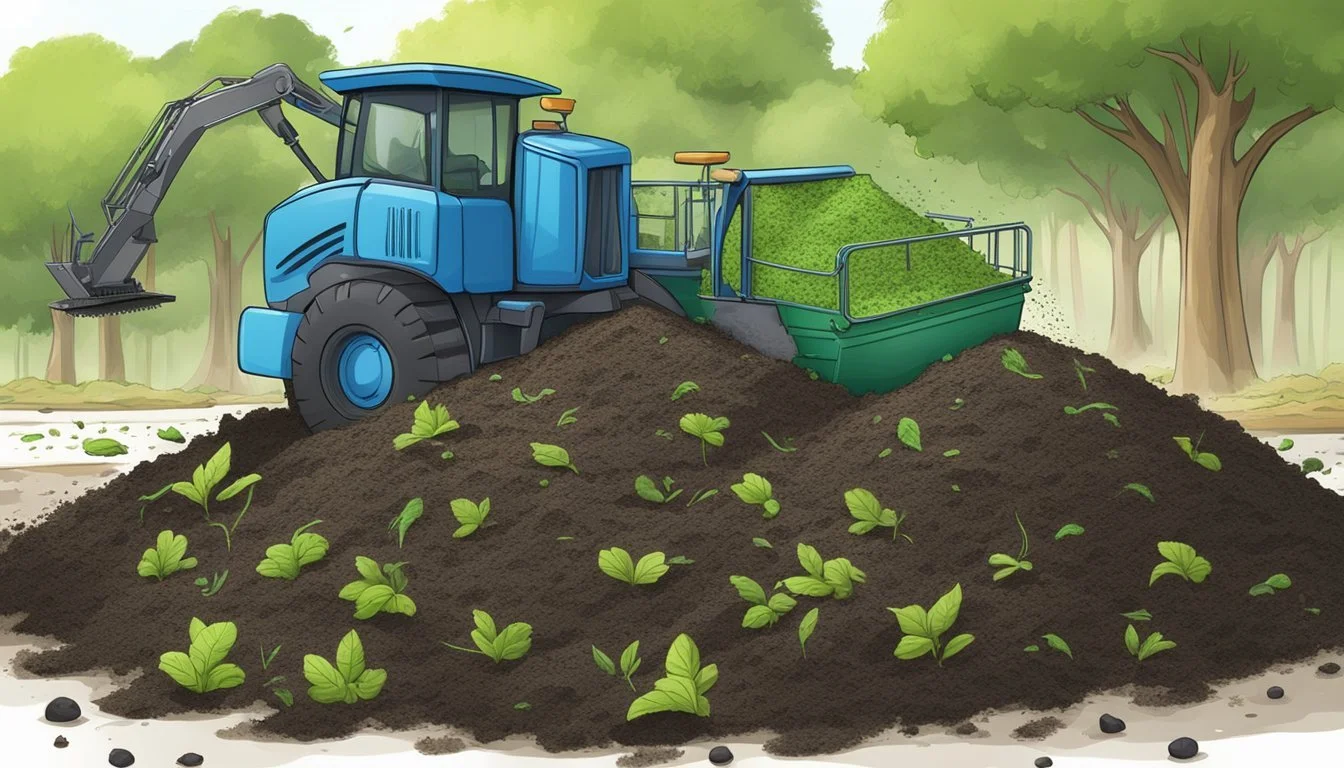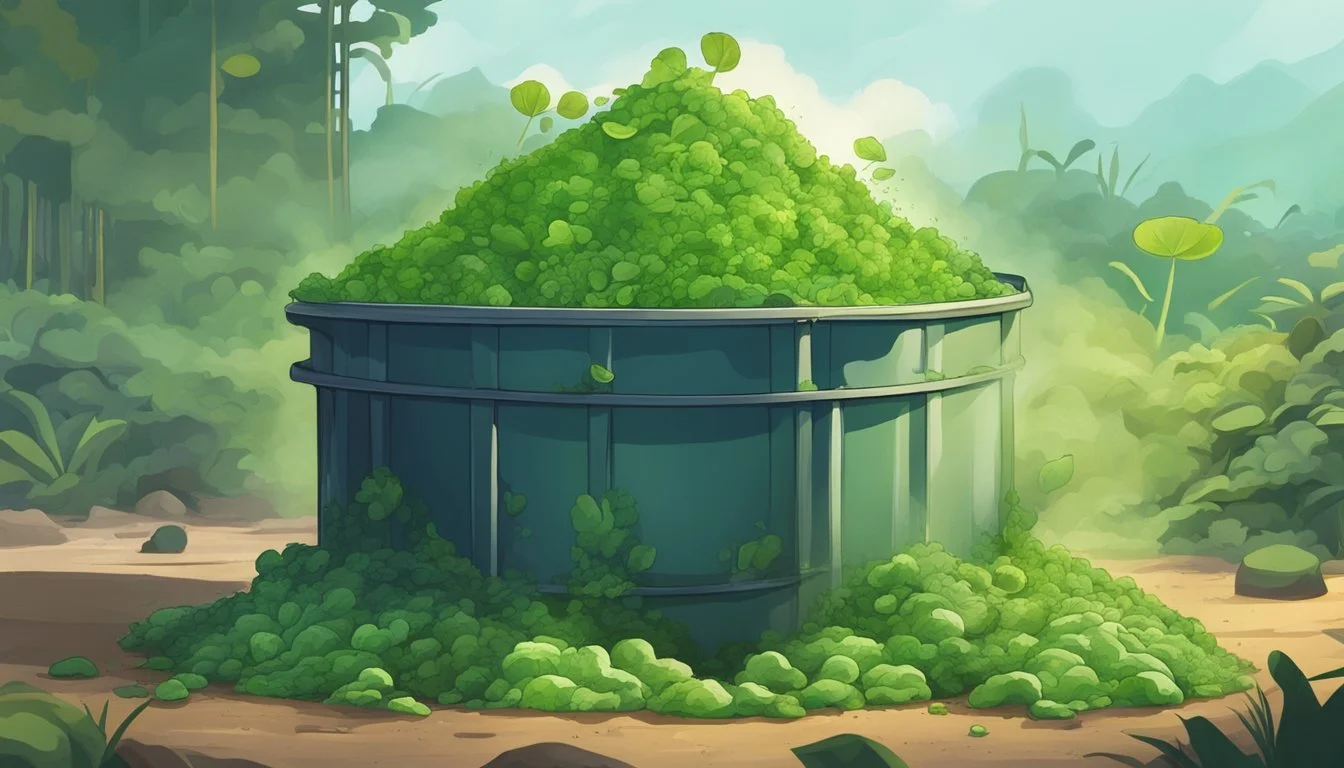Can You Compost Algae?
Unpacking the Benefits and Methods
Algae, commonly perceived as a nuisance in ponds and aquariums, can be a valuable addition to compost. This aquatic plant is a rich source of nitrogen, a crucial element in the composting process that helps to break down organic matter into fertile soil. Composting algae effectively recycles nutrients, returning them to the soil where they can benefit garden plants.
When algae is added to a compost pile, it decomposes rapidly due to its soft cellular structure. This rapid breakdown releases nutrients, such as potassium and phosphorus, which are essential for plant growth. The use of algae in compost prevents the wasteful disposal of pond scum and provides an alternative to synthetic fertilizers, aligning with environmentally friendly gardening practices.
It is essential to balance algae with carbon-rich materials in compost to avoid an overly wet and smelly compost pile. Correctly managed, composting algae can provide gardeners with nutrient-dense compost that enhances soil vitality and plant health.
Understanding Algae and Its Role in Composting
Algae, often perceived as simple aquatic plants, can be a valuable addition to composting processes, offering both benefits and challenges due to their unique properties.
Types of Algae Suitable for Composting
Algae are classified broadly into two groups: microalgae and macroalgae. Microalgae include unicellular species such as blue-green algae, which are often found in freshwater environments. Macroalgae, commonly known as seaweed, are multicellular and typically inhabit marine spaces. Both types can be composted, but the most common form used in composting is seaweed, due to its higher lignin content and readily available biomass.
Blue-green algae (also classified as Cyanobacteria): Often harvested from freshwater ponds or lakes.
Red algae: Found in marine environments and are less common in composting.
Seaweed: Collected from seashores and often used as composting material due to its abundance and nutrient profile.
Benefits of Algae in Compost
One of the main benefits of incorporating algae into compost is its high nitrogen content, which accelerates the composting process and enriches the final product. Algae can also improve soil structure and water retention when composted soil is used.
Nutrient-rich: Provides a good source of potassium, phosphorus, and micronutrients.
Soil conditioner: Enhances soil texture and promotes beneficial microorganisms.
Potential Concerns with Algae Composting
However, there are some considerations to be aware of when composting algae:
High moisture content: Can lead to an imbalance in the compost heap if not managed correctly.
Low carbon-to-nitrogen (C/N) ratio: Risks nitrogen loss as ammonia or nitrous oxide if not blended with high-carbon materials.
Anaerobic conditions: Due to its density, algae can compact and create oxygen-depleted pockets which may necessitate frequent turning of the pile.
Concern Implication Mitigation Strategy High moisture Soggy compost pile Blend with dry, carbon-rich materials Low C/N ratio Potential nitrogen loss Balance with materials like straw or leaves Oxygen depletion Odors and slower decomposition Regular aeration of the compost pile
By managing these factors, composters can effectively integrate algae into their composting systems, taking advantage of its nutrient profile while mitigating potential drawbacks.
The Composting Process
Composting is an organic process that transforms waste materials into a nutrient-rich soil amendment. This section will explore the essential components and factors that facilitate the transformation of algae into compost.
Basic Composting Elements
To establish a successful composting operation, one must combine organic waste with moisture, oxygen, and microorganisms. An optimal compost pile should be a balanced mix of green materials, rich in nitrogen, and brown materials, high in carbon. While algae typically possess a low carbon to nitrogen ratio, suggesting a potential for increased nitrogen loss, they can be composted effectively with careful management.
The Role of Nitrogen and Carbon in Composting
Nitrogen is crucial for the growth of decomposing bacteria within the compost pile. It is often found in 'green' materials, while carbon comes from 'brown' materials and provides energy for the microorganisms. A common target ratio is 30:1 of carbon to nitrogen, which helps to create a dark brown, crumbly texture compost with an earthy aroma upon completion.
Microorganisms and Decomposition
Microorganisms, including bacteria, fungi, and other decomposers, are the workhorses of the composting process. They break down organic material into simpler compounds. In the case of algae, its high moisture content and low porosity may necessitate adjustments to provide enough air for microorganisms and prevent anaerobic conditions.
Factors Affecting Compost Quality
The quality of the resulting compost is determined by variables like moisture content, temperature, the ratio of carbon to nitrogen, and oxygen availability. To achieve high-quality compost, these elements need to be carefully monitored and adjusted to maintain the balance necessary for effective decomposition.
Incorporating Algae into Your Compost Pile
Algae, a living organism rich in nitrogen, can decompose rapidly in a compost pile, enriching it with essential nutrients. Proper implementation ensures the success of composting algae, particularly when sourced from pond scum or accumulated string algae.
Methods for Adding Algae to Compost
When introducing algae to a compost pile, they should employ a layering technique to distribute the algae evenly. She should alternate layers of algae with other compost materials, such as leaves or straw, to maintain balance. The algae layer should be no more than a couple of inches thick to prevent it from compacting and becoming anaerobic.
Direct Mixing: If algae are readily available, mix them directly into the pile.
Dried Application: For those who prefer pre-drying the algae, it can then be crumbled and sprinkled throughout the compost.
Conditions for Optimal Decomposition
For algae to decompose effectively in a compost pile, there should be an optimal moisture level – the pile should be as wet as a wrung-out sponge. They need to aerate the pile regularly to supply oxygen that aids the microbes in breaking down the algae. The compost should not be overly wet or dry, as this can slow down the decomposition process or cause odor issues.
Aeration: Turn the pile every few weeks to introduce oxygen.
Moisture Control: If too wet, add dry, carbon-rich materials; if too dry, sprinkle water during aeration.
Monitoring and Maintenance for Algae Composting
Ongoing monitoring and maintenance are vital for the successful composting of algae. They need to check the compost pile regularly for moisture level and aeration. If the pile begins to emit a foul odor or the decomposition process slows, additional aeration or adjustment to the moisture level may be required.
Regular Checks: Inspect the pile weekly and adjust as necessary.
Odor Management: A well-mixed pile that's properly aerated will have an earthy scent, not a foul one.
Benefits of Algae-Based Compost for Soil and Plants
Algae-based compost offers unique advantages for soil enrichment and plant development due to its nutrient-rich profile and rapid decomposition rate. This compost can be a vital component in sustainable gardening practices.
Improving Soil Structure
Algae compost contributes significantly to soil structure by increasing the content of organic matter. When incorporated into the soil, algae:
Enhance soil aeration, which is essential for healthy root and microbial activity.
Boost water retention, providing a more consistent moisture supply to plants.
Promote beneficial microbial populations, which are crucial for nutrient cycling and soil health.
The incorporation of algae as a fertilizer helps to improve root growth by creating a conducive soil environment, leading to stronger and more resilient plants.
Enhancing Plant Growth and Yield
Algae-based compost is a powerhouse of nutrients, offering plants a balanced supply of nitrogen, potassium, and phosphorus, among others:
Nitrogen aids in the formation of chlorophyll, essential for photosynthesis.
Potassium regulates plant metabolism and is involved in water uptake.
Phosphorus is critical for energy transfer and genetic material development in plants.
These essential nutrients not only stimulate plant growth but can also enhance the yield by improving overall plant health and productivity. Algae fertilizer, being of natural origin, supports a sustainable approach to gardening, avoiding the pitfalls of soil and water pollution associated with synthetic fertilizers.
Other Organic Materials for Compost
In addition to algae, a well-balanced compost pile incorporates a diverse mix of raw materials. These traditionally include assorted kitchen refuse, nitrogen-rich substances, and carbons like straw or leaves to maintain the pile's moisture equilibrium.
Using Garden and Kitchen Scraps
Garden remnants such as dead leaves, mulch, and straw can be combined with kitchen scraps like vegetable scraps and coffee grounds to enrich compost. They introduce beneficial microorganisms and decompose to add nutrients to the compost. It's essential, however, to avoid diseased plant material or invasive weeds that might survive the composting process and spread when the compost is applied to the garden.
Kitchen scraps:
Vegetable peels
Fruit waste
Coffee grounds
Tea bags (make sure they are not made of synthetic material)
Garden waste:
Dead leaves
Straw
Non-treated grass clippings
Adding Manure and Other High-Nitrogen Substances
Manure from herbivores such as horses or cows is an excellent source of nitrogen, which helps heat up the compost pile and speeds decomposition. Fresh and dried grass clippings also contribute substantial nitrogen content. It is important to source manure that has not been contaminated with insecticides or medications that could harm the compost's microbial life and end up in garden soils.
High-nitrogen materials:
Fresh grass clippings
Dried grass clippings
Cow manure
Horse manure
Balancing Moisture with Dry Materials
Maintaining a balance between wet and dry ingredients is critical for optimal composting conditions. Cardboard, straw, and old hay provide necessary carbon, aiding in the absorption of excess moisture while permitting air circulation. The inclusion of such dry materials prevents the compost from becoming overly soggy, which can lead to bad odors and poor decomposition.
Dry materials to balance moisture:
Shredded cardboard
Straw
Old hay
Safety and Environmental Considerations
When composting algae from environmental bodies such as ponds and lakes, it is crucial to consider safety and environmental impacts. Ensuring that composting processes are environmentally friendly and do not introduce heavy metals into organic systems is integral for maintaining ecological balance.
Identifying and Mitigating Heavy Metal Risks from Algae
Heavy metals can accumulate in algae, especially when they grow in polluted waters. During algae composting, it's essential to:
Test the algae: Analyze for heavy metal content before composting to prevent contamination.
Source responsibly: Use algae from cleaner waters to minimize risks.
Composting Algae Responsibly
The process of composting algae must address certain peculiarities to be environmentally sustainable:
Manage C/N ratios: Algae often has a low carbon to nitrogen (C/N) ratio, which necessitates careful balancing to avoid greenhouse gas emissions like N2O.
Control moisture and aeration: High moisture content and low porosity in algae can hinder proper composting. Implement measures to ensure optimal aeration and moisture levels, such as turning the compost regularly.
By adhering to these practices, composting algae can be a safe and effective method to recycle nutrients back into the environment.
Optimizing Compost for Different Uses
Composting algae can lead to a rich soil amendment, but for optimal results, it's critical to tailor the compost blend to the intended use, whether for gardens or potted plants, and to adjust the nutrient profile to meet specific plant needs.
Tailoring Compost for Gardens Versus Potted Plants
For garden use, a compost mix enriched with algae can improve soil structure and fertility. Combining algae compost with topsoil enhances its ability to retain moisture and provide essential nutrients. It is beneficial to mix the compost into the garden soil to assist in slow-release of nutrients.
For indoor plants, using algae compost requires more finesse. Mix algae compost with potting soil to ensure it is well-aerated and not too dense. Incorporate materials like perlite or coarse sand to improve drainage and prevent root rot.
Creating Compost Mixes with Specific Nutrient Profiles
Plants depend on a balanced diet of macronutrients and micronutrients for optimal growth. Algae-based compost generally offers a high nitrogen content; however, tailoring it to specific nutrient requirements is crucial.
A nutrient profile with higher levels of potassium and phosphorus, besides nitrogen, supports flowering and fruiting plants.
Compost for foliage plants might require a higher nitrogen ratio to encourage leaf growth.
Here's a simple guide for nutrient balance in algae compost mixes:
Nutrient Profile High Nitrogen Balanced N-P-K High Phosphorus Use Case Leafy Greens General Garden Flowering Plants Mix Ratio 3:1:2 1:1:1 1:2:2
In creating these mixes, gardeners should adjust compost ratios according to the specific nutrient needs of their plants, maintaining a diligent approach to avoid over or under-fertilization.
Advanced Topics in Algal Composting
In the realm of composting, algae presents unique challenges and opportunities. Innovative harvesting techniques and research into the composting process expand the utility of algae as an effective composting material.
Innovative Approaches to Algae Harvesting for Compost
Technological advancements have paved the way for efficient algae harvesting methods tailored for compost production. Researchers employ pond algae skimmers, similar to those used in swimming pool maintenance, to collect algae with minimal impact on the aquatic ecosystem. Such devices have been adapted to gather large quantities of algae, which is a crucial step before it can be transformed into compost.
The specialized equipment includes mechanized harvesters that sieve algae from water bodies, concentrating the biomass for processing. In some cases, these systems are coupled with drying mechanisms to reduce moisture content, a factor essential for optimizing the composting process.
Case Studies and Research on Algae in Compost
Academic institutions, like the University of Illinois Cooperative Extension, have conducted studies illustrating the nuances of algae composting. One case study focused on integrating thermophilic aerobic composting methods to treat algal sludge from eutrophic waters. This approach not only mitigated environmental problems associated with harmful algal blooms but also resulted in a value-added organic fertilizer.
Research highlights include:
Algae's low carbon-to-nitrogen ratio, which can lead to significant nitrogen loss if not managed properly.
The importance of controlling moisture content and porosity to prevent compaction and ensure aeration within the compost pile.
These studies underscore the importance of controlling composting parameters to harness the full potential of algae as a nutrient-rich compost feedstock. Algae's peculiarities, when managed correctly, can contribute significantly to sustainable waste management and soil health improvement strategies.
Tools and Equipment for Algae Composting
Before one begins composting algae, it is crucial to have the right tools for harvesting and managing algae, as well as the appropriate composting systems ready to process the organic matter efficiently.
Essentials for Harvesting and Managing Algae
Harvesting and managing algae require tools that are gentle on the ecosystem but effective in gathering the necessary biomass. A manure fork is versatile and can be used to scoop large clumps of algae from ponds. For finer harvesting, especially in smaller bodies of water, one might opt for a rake with tines fine enough to collect algae without disturbing aquatic life excessively.
Rake: Appropriate for surface collection from small ponds.
Manure fork: Ideal for bulky, large-scale algae removal.
Managing collected algae entails ensuring it is prepared for the composting process. The algae should be briefly dried but not desiccated, as beneficial moisture is required for composting.
Compost Bins and Systems Suitable for Algae
Composting systems that cater to algae need to provide the right conditions for decomposition while controlling moisture and odor. A compost bin designated for organic waste can be an excellent container for composting algae. Here is what to consider:
Compost bin characteristics:
Size: Depending on the volume of algae, choose a bin ranging from small to large scale.
Ventilation: Adequate aeration speeds up the composting process and reduces odors.
Material: Durable materials like plastic or coated metal resist corrosion from moisture.
When composting algae, the nitrogen-rich biomass interacts with other compost materials, accelerating decomposition and producing quality compost. One should layer the algae with carbon-rich elements like dry leaves or straw to balance the compost pile. A compost bin with a lid can also help manage odor and pest attraction.
Remember, while tools and equipment are vital, understanding the composting process and how algae behave within it is equally important.
Preparing for Seasonal Changes
Composting algae is a sustainable practice that can be adjusted to accommodate the varying conditions of each season. Proper preparation ensures the process is efficient and effective throughout the year.
Algae Composting in Spring and Summer
In the warmer months, algae decomposition is generally more rapid due to higher temperatures, which accelerates microbial activity. Composters should ensure there is adequate moisture in their piles to facilitate the composting process. Spring planting often yields an abundance of algae, particularly from pond cleanups, making it an ideal time to enrich compost. It is essential to monitor moisture levels and turn the compost pile regularly to ensure even decomposition.
Spring: Add fresh algae to compost as a nitrogen-rich green material during pond cleanups.
Summer: Balance with brown materials, such as straw or newspaper, to maintain the compost’s moisture levels.
Maintaining Compost Piles Through Fall and Winter
As temperatures drop in the fall, so does the microbial activity in compost piles. During these cooler months, one might cover the compost pile to retain heat and moisture. It is also a time to add layers of fallen leaves, which are dry and carbon-rich, to balance the wetter green material like algae.
Fall: Introduce dry leaves and maintain a cover to trap heat.
Winter: Although composting slows down, it should not be halted. Occasional turning might be required to prevent the pile from becoming too wet or compacted, and to protect it from freezing completely. This practice is not only effective but also generally free of cost, leveraging natural seasonal waste.








